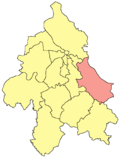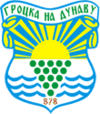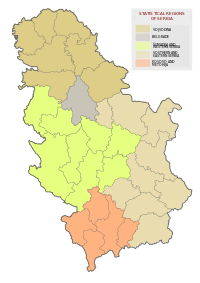Grocka
| Grocka Гроцка Гроцка на Дунаву / Grocka na Dunavu (trans. Grocka on Danube) | ||
|---|---|---|
| Municipality and town | ||
| ||
 Location of the municipality of Grocka within Serbia | ||
| Country |
| |
| District | Belgrade | |
| Settlements | 15 | |
| Government | ||
| • Mayor | Dragoljub Simonović(SNS) | |
| Area[1] | ||
| • Municipality | 289 km2 (112 sq mi) | |
| Population (2011 census)[2] | ||
| • Town | 8,233 | |
| • Municipality | 83,398 | |
| Time zone | CET (UTC+1) | |
| • Summer (DST) | CEST (UTC+2) | |
| Postal code | 11306 | |
| Area code | +381 011 | |
| Car plates | BG | |
| Website |
www | |
Grocka (Serbian Cyrillic: Гроцка, pronounced [ɡrǒtskaː]) is a town and one of 17 city municipalities which constitute the City of Belgrade, the capital of Serbia.
Municipality

Location
The municipality is located east of Belgrade, in the northern part of Šumadija region, with the northern section being part of the Podunavlje macro-region in the valley of the Danube, while the southern section is located around the valley of the Ralja river, which is a tributary to the Velika Morava's arm of Jezava. With an altitude of 71 meters above sea level, the town of Grocka is one of the lowest parts of Belgrade.[3] Other rivers in the municipality are Bolečica and Gročica.
Settlements
The municipality of Grocka covers an area of 289 km² and includes 15 settlements, all of which are statistically classified as rural, except for the municipal seat of Grocka, which is urban.
|
|
|
|
|
|
|
Population
The municipality has a population of 83,398 (census 2011) (289 per km²). Thanks to the immigration and the natural increase of all of the city's municipalities, Grocka has been for decades one of the fast-growing areas of Belgrade, with an average annual growth of 1.2% in the 2000s. The population boomed in the last 30 years, increasing the number of inhabitants (1971-2005 by 2.23 times; in 1971-81 the population grew by 4.5% annually). As in other similar areas surrounding Belgrade, the rapid population growth has not followed by the equal development of infrastructure (roads, waterworks, sewage system, and waste disposal).
Population of the municipality:
- 1961: 32,836
- 1971: 35,275
- 1981: 54,599
- 1991: 65,735
- 2002: 75,466
- 2005: 78,825
- 2011: 83,398
With refugees from Bosnia, Croatia and Kosovo and Metohija, it is estimated that the population has already crossed 100,000. The ethnic structure is, as of the 2002 census: Serbs 94,7%, Montenegrins 0,8%, Romani 0,6%, Ethnic Macedonians 0,5%.
Economy
In both demographic and economic terms, the municipality is sharply divided into two opposing parts. The western part extends into one urban area with Belgrade, experiencing a boost of both population and economy, as hundreds of small companies are located there (Kaluđerica, Boleč, Leštane, Vinča, Ritopek are some), while the eastern part is agricultural, in particular a fruit growing area, and, apart from the town of Grocka itself, experiencing a net decline in population.
The Microclimate is perfect for the fruit growing and grapevines, so the area east of Boleč is one of the best known fruit growing area in Serbia. Conditions are especially good for growing peaches, apricots, plums, cherries and grapes. Of the other agricultural products, wheat is the most important. The experimental farm of Radmilovac is located near Vinča, as a section of the University of Belgrade Faculty of Agriculture. At the moment, Radmilovac is being expanded as an experimental ground for future agricultural production.
As a result of this, industrial processing of the fruit is developed in Grocka, Vinča and Boleč, where the large plantations and refrigeration plants of the agricultural company PKB Beograd are located. Also, several mills are located in Grocka and Vinča.
Apart from that, the textile industry is also important (Grocka, Dunav factory, aka:Partizanka), while hundreds of small family-owned factories and workshops are located in the settlements in the western part of the municipality.
Some major traffic routes, like the Smederevski put (Smederevo road) and both the railway and highway Belgrade-Niš, pass through the municipal territory. Also, there are several docks in the settlements on the Danube (Vinča, Grocka) with the prospect of a future marina to be built in Grocka in the next few years.
Other important facilities in the municipality are the Geomagnetic observatory in Brestovik, Nuclear Institute (with now defunct nuclear reactor) and Belgrade City dump in Vinča.
Tourism is the most developed part the municipal economy. Almost every village has its own summer festival (like Zlatni kotlić (Golden Cauldron) in Grocka or Dani trešnje (Days of cherry) in Ritopek) and three weekend-settlements (mostly by the inhabitants of Belgrade) are located in Grocka, on the bank of the Danube. The women's monastery of Rajinovac in Begaljica, the possible marina and aqua park in Grocka and the archeological find of Vinča culture are potential opportunities to boost the tourist economy.
History
The municipality of Grocka became part of the wider Belgrade City area in 1955. In 1957 with the dissolution of the Mali Mokri Lug municipality, the eastern section (the villages of Kaluđerica, Leštane and Vinča) were attached to Grocka. In the early 1960s, the municipalities of Umčari and Vrčin were disbanded and incorporated into the municipality of Grocka as well. Since the elections in 2000, Grocka became the most politically turbulent of all Belgrade municipalities.
Recent Presidents of the Municipal Assembly:
- 1992 - 1996 - Bogoljub Stevanić (1943)
- 1996 - November 24, 2000 - Milan Janković (1954)
- November 24, 2000 - June 28, 2002 - Vesna R. Ivić (1962)
- June 28, 2002 - December 8, 2002 - Milan Tanasković
- December 8, 2002 - April 15, 2003 - Sava Starčević (1955)
- April 15, 2003 - December 15, 2004 - Vladan Zarić (1972)
- December 15, 2004 - June 23, 2005 - Blažo Stojanović
- June 23, 2005 - November 4, 2005 - Dragoljub Simonović (1959)
- November 4, 2005 - June 12, 2008 - Blažo Stojanović (second term)
- June 12, 2008 - June 15, 2012 - Zoran Jovanović
- June 15, 2012 – present - Dragoljub Simonović (second term)
As a result of the economic and demographic discrepancy between the western and eastern parts of the municipality, there is a movement for splitting the municipality in two, or perhaps three parts. Primarily, it is about the division in two, with western half becoming new municipality of Vinča, while eastern remaining the municipality of Grocka. Also, there is a possibility of Vrčin splitting from Grocka and forming new municipality of Avalski Venac with other sub-Avalan settlements in the municipality of Voždovac (Beli Potok, Zuce, Pinosava).
Town
Location and population
Grocka is a small town, located on the right bank of the Danube, where the small river of the Gročica (Cyrillic: Грочица) empties into the Danube, 30 km east of Belgrade. Despite being seat of the municipality, in term of population, it is only the fourth largest settlement in the municipality, after Kaluđerica, Vrčin and Leštane. The population of Grocka:
- 1921 - 2,808
- 1953 - 3,200
- 1971 - 4,955
- 1981 - 6,394
- 1991 - 7,420
- 2002 - 8,338
- 2005 - 8,719
- 2011 - 8,233
Economy
Grocka is at the center of one of the best known fruit growing areas in Serbia. Conditions are especially favorable for growing peaches, apricots, plums, cherries and grapes. Industrial processing of the fruit has been developed. There are also several mills and a textile industry (Kluz factory).
Traffic is also important as Grocka is located on the road of Smederevski put. It also has a small harbor on the Danube, at the Gročica's mouth (which regularly floods Grocka).
Tourism is important for the town's economy, with several festivals during the year (most notably, the Zlatni kotlić). Large weekend-settlement (mostly by the inhabitants of Belgrade) is built on the eastern extension of the town.
Culture and history
Town has a historical main street with shops, green market and a small administrative center, which has been turned into a pedestrian zone.
The area on which modern town Grocka is located was once part of Limes, a border defense system of Ancient Rome. The remains of several watch-towers and small forts were found in nearby villages along the banks of the Danube river. The town was first time mentioned in 878 under Slavic name Gradec, while present settlement of Grocka was esdtablished in 1550.
Notable people
- Milan Nedić, born in Grocka. A general, but mostly known as a Prime Minister of the Nazi-backed Territory of the Military Commander in Serbia during World War II.
- Vesna Pešić, born in Grocka. Is a retired university professor and a politician, one of the longest serving leaders of opposition movement in Serbia.
- Stanislava Pešić, born in Grocka. Was a Serbian actress.
- Bojan Mamić, lived in Grocka. He is a Serbian footballer.
- Ivan Paunić, lived in Grocka. He is a Serbian basketball player.
- Vasa Čarapić, was duke of Grocka. He was one of notable figures of the First Serbian Uprising.
- Ilija Čarapić, was duke of Grocka at age of 18. He was the first Mayor of Belgrade.
- Ilija Garašanin Spent last years of his life and died on his estate in Grocka. He was Serbian statesmen and a politician.
International relations
Twin towns – Sister cities
See also
References
- ↑ "Municipalities of Serbia, 2006". Statistical Office of Serbia. Retrieved 2010-11-28.
- ↑ "2011 Census of Population, Households and Dwellings in the Republic of Serbia: Comparative Overview of the Number of Population in 1948, 1953, 1961, 1971, 1981, 1991, 2002 and 2011, Data by settlements" (PDF). Statistical Office of Republic Of Serbia, Belgrade. 2014. ISBN 978-86-6161-109-4. Retrieved 2014-06-27.
- ↑ Politika, April 20, 2008, front page
- ↑ Stalna konferencija gradova i opština. Retrieved on 2007-06-18.
- Mala Prosvetina Enciklopedija, Third edition (1985); Prosveta; ISBN 86-07-00001-2
- Jovan Đ. Marković (1990): Enciklopedijski geografski leksikon Jugoslavije; Svjetlost-Sarajevo; ISBN 86-01-02651-6
External links
| Wikimedia Commons has media related to Grocka. |
Coordinates: 44°40′N 20°43′E / 44.667°N 20.717°E



